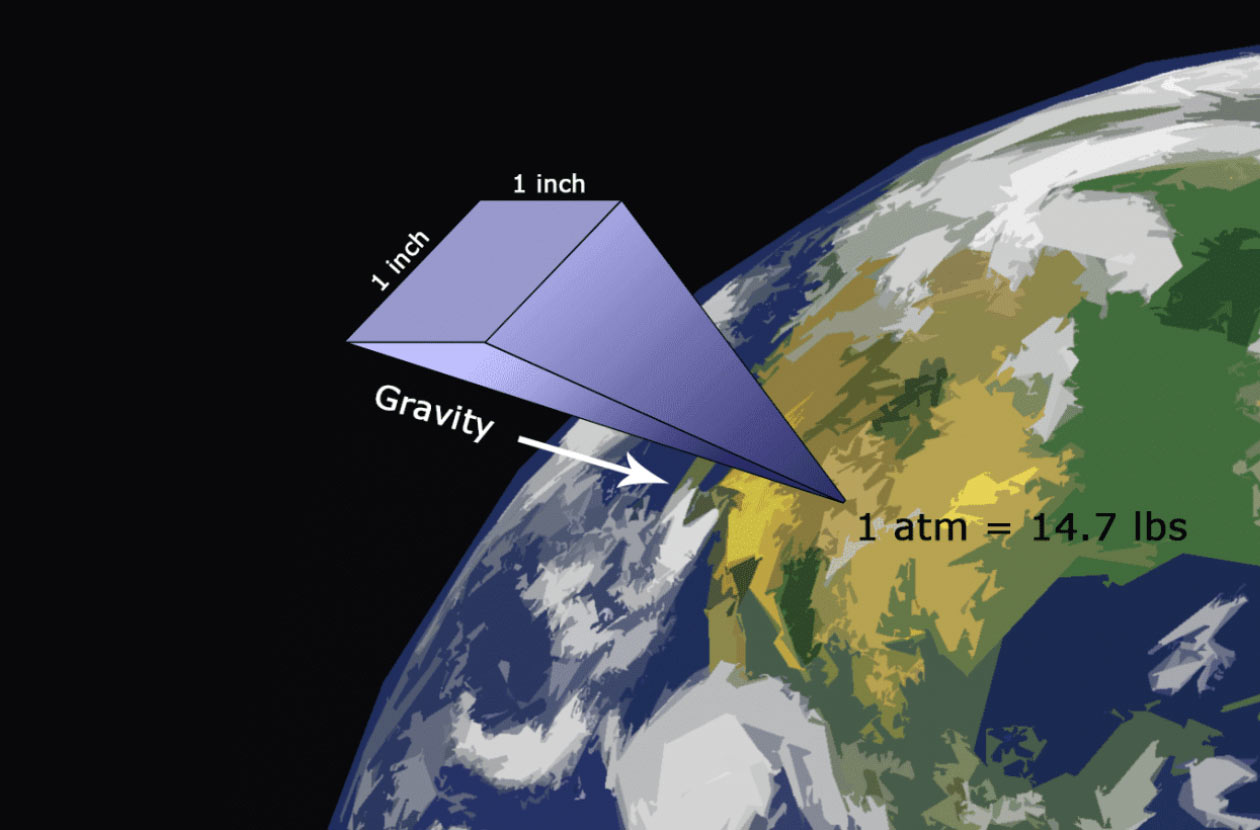Atmospheric pressure, is an indicator of how much coffee you will drink today. And on a more serious note, changes in this pressure can significantly affect our mood. For us divers, it is also an essential part of dive planning. Today you will learn everything you need to know about atmospheric pressure in simple terms.
Did you sleep a bit in physics classes at school and don’t quite remember what all the pressure was about? Don’t worry, I wasn’t the best student in the class either. But now, as a scuba diving instructor, I can explain to my students what it’s all about. After reading this text, you too will know all about atmospheric pressure. Shall we begin?
Table of Contents
What is the atmospheric pressure?
Let’s start with the basics, which is what exactly atmospheric pressure is. As you read this text, your lungs are constantly filling up with air, because we need it to live. This air, although invisible at first glance, is composed of various particles. And it all has its own weight. So the air “weighs”. And when it presses on any surface with its weight, this is what we call atmospheric pressure.
In other words, this pressure refers to the force exerted by the Earth’s atmosphere on a given surface. It is the weight of the air above that surface, caused by the Earth’s gravitational attraction to air molecules. Simple isn’t it?

How do we measure atmospheric pressure?
To talk about the impact of pressure on our lives, we first need to measure it somehow. Fortunately, this is something that has been around for a long time, as the first pressure measuring device was built by Torricelli in 1643. Atmospheric pressure is commonly measured with a device called a barometer. There are different types of barometers, but the two most commonly used are the mercury barometer and the aneroid barometer.
Mercury barometer
This type of barometer consists of a long glass tube that is closed at one end and filled with mercury. The open end of the tube is submerged in a container of mercury. Atmospheric pressure exerts pressure on the mercury in the container, causing it to rise up the tube. The height of the mercury column is a measure of pressure. Standard atmospheric pressure at sea level can support a column of mercury about 760 millimeters (mm) high, which is known as one standard atmosphere (atm).
Aneroid barometer
Unlike a mercury barometer, an aneroid barometer does not use a liquid. Instead, it uses a small, flexible metal box called an aneroid cell. This cell is sensitive to changes in atmospheric pressure. As the pressure changes, the cell expands or contracts, which then translates into a corresponding movement of the needle on the dial. The dial is calibrated to provide a pressure reading.
Digital barometer
Nowadays, modern digital barometers are also available that use electronic sensors to measure atmospheric pressure. Their advantage is that they provide accurate and instantaneous readings of atmospheric pressure.
Atmospheric pressure measurement scale
Ok, so we already know what we can measure atmospheric pressures with, and now we need to adopt some common measurement scale. Here, unfortunately, as always, several measurement scales have been created and it is understood that they can cause confusion. So let’s see what we measure this pressure in:
-
Pascal (Pa): The pascal is the SI unit of pressure. One pascal is equal to one newton per square meter (N/m²). Atmospheric pressure is typically measured in kilopascals (kPa) or hectopascals (hPa), where 1 kPa = 1000 Pa and 1 hPa = 100 Pa.
-
Bar: The bar is a unit of pressure derived from the cgs (centimeter-gram-second) system. One bar is equal to 100,000 pascals. Atmospheric pressure is often reported in millibars (mb), where 1 mb = 1 hPa.
-
Millimeters of Mercury (mmHg): This scale is commonly used in meteorology and aviation. It represents the height of a column of mercury that the atmospheric pressure can support. The standard atmospheric pressure at sea level is approximately 760 mmHg.
-
Inches of Mercury (inHg): This scale is similar to mmHg but uses inches as the unit of measurement. One inch of mercury is equivalent to approximately 25.4 mmHg. The standard atmospheric pressure at sea level is approximately 29.92 inHg.
-
Atmosphere (atm): The atmosphere is a unit of pressure representing the average atmospheric pressure at sea level. One atmosphere is approximately equal to 101,325 pascals, 1013.25 millibars, 760 mmHg, or 29.92 inHg.
Measuring pressure in diving
As you can see we have several different scales of measurement and this can cause some confusion. The different scales have a slightly different purpose, but when it comes to measuring pressure in scuba diving we mostly use BAR or ATM (atmosphere). These scales are used to determine the pressure of air as well as water.

Differences in atmospheric pressure
Atmospheric pressure changes with altitude. The higher you go, the lower the pressure. Conversely, the closer you are to sea level, the higher the pressure. Surely you are familiar with the fact that climbers in high mountains have oxygen cylinders so that they can breathe fairly normally. This is due to the low pressure at high altitudes. Because this leads to lower air density, and thus less oxygen per liter of air. So with each breath you take in less oxygen which you need to live.
But altitude is not the only thing affecting the change in atmospheric pressure. It can also vary due to factors such as weather conditions, location and time fluctuations. Atmospheric pressures are also heavily influenced by unique weather events like storm fronts or hurricanes. In general, pressure shows fluctuations due to many factors and can affect your mood, among other things.
Atmospheric pressure and your mood
It has been suggested that atmospheric pressure can potentially affect your mood. Some individuals may experience changes in mood or physiological effects in response to changes in pressure, although scientific evidence is limited and inconclusive.
It is thought that changes in atmospheric pressure, especially abrupt or significant ones, can affect the balance of certain chemicals and neurotransmitters in the brain, potentially leading to changes in mood. Some people say they experience symptoms such as headaches, fatigue, irritability or changes in sleep patterns during periods of fluctuating pressure, such as before a weather change. That is, something like jetlag after a long trip.

However, it is important to remember that the relationship between atmospheric pressure and mood is highly individual and not universally experienced. Many factors, including personal sensitivity, pre-existing health conditions and psychological factors, can also affect mood. If you feel such an effect related to the change in atmospheric pressure, just have a cup of good coffee 🙂
Pressure changes and scuba diving
While the impact of a change in pressure on your mood can be very individual, the impact of a rapid change in pressure on divers is already a serious aspect. Most diving problems or accidents are precisely related to the change in pressure. Of course, water pressure is a topic for another text, but I must point out something very important here. During diving, our body is exposed to increased pressure. And this is a significant difference, which, depending on the depth, reaches several times the pressure at the surface.
This in turn leads to the absorption of nitrogen, which is part of the air we breathe. Since our body does not have the ability to process this nitrogen, it will be accumulated in our tissues but after diving it will be removed over time. For this, however, we need the atmospheric pressure we have at sea level, which is 1 atmosphere. If we reduce this pressure, the accumulated nitrogen will also be released, but much too quickly. This can lead to nitrogen bubbles, which in turn can lead to serious health consequences. From this follows a very simple rule that after a dive it is a bad idea to go up in the mountains or fly in an airplane.
Atmospheric pressure – let’s recap
I hope that if you had any doubts about what exactly atmospheric pressure is, you no longer have them now. As you can see, we are constantly subjected to various forces and changes beyond our control. Remember that diving without a basic knowledge of these relations will be at least dangerous, and certainly not very wise. If you want to learn about the underwater world, sign up for a scuba diving course at your nearest dive center and learn what every diver should know. So that you not only look, but also speak like a diver.







